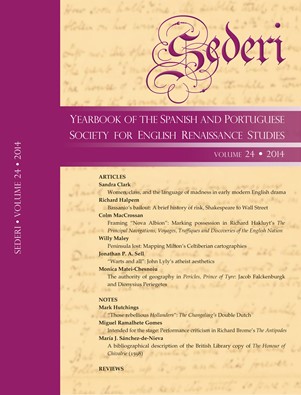Peninsula lost: Mapping Milton’s Celtiberian cartographies
Keywords:
Britain, Catholicism, Celtic, colonialism, Cromwell, Empire, England, Europe, Iberia, Ireland, John Milton, monarchy, Naples, “New World”, Portugal, Revolution, Spain, translationAbstract
In A Mask Presented at Ludlow Castle (1634), John Milton depicts Comus “ripe and frolic of his full grown age, Roving the Celtic and Iberian fields.” While Milton’s complex engagement with Portugal and Spain has been the subject of some discussion by critics, few attempts have been made to place his writings on the Iberian Peninsula within the wider context of his theories of climatic influence and colonialism, beyond the “western design” against Spanish colonial possessions. Anti-Catholicism and anti-imperialism may be the key to Milton’s Cromwellian correspond-ence with Spain and Portugal on behalf of the English republic in the 1650s but his Iberian interests can be viewed too as part of a deeper excavation of British and Irish histories. The purpose of this article – its “roving commission” – is to explore the presence of the Peninsula in Milton’s work from “Lycidas” (1637) through to The History of Britain (1670) in relation to recent archipelagic readings of Milton, examining the ways in which Celtic and Iberian concerns are intertwined in Milton.
Downloads
Downloads
Published
Issue
Section
License
The copyright holder of the published contributions is SEDERI.The hardcopy and an open-access version of the journal will be published simultaneously. The issues will be available online in the SEDERI website (http://www.sederi.org/yearbook/) and other repositories that have signed an agreement with SEDERI.
The authors who publish with this journal agree to the following terms:
a) SEDERI retains copyright of the essay.
b) If the author wishes to republish or rewrite the essay for another journal, or include the essay published in SEDERI in their personal repositories, or in any other way, they should contact the editors to obtain permission to do so. This will entail citing SEDERI as the original source and sending the editors a copy of the new version, or the link to the website, in case of online publishing.
The author(s) hereby warrant(s) that:
a) The essay submitted for publication is an original creation and does not infringe any copyright or property right of another journal, author or publisher.
b) The essay submitted for publication has not been previously published, whole or in part, and is not being considered for publication elsewhere.
c) Written permission has been obtained for any material from other sources included in the essay submitted for publication.




